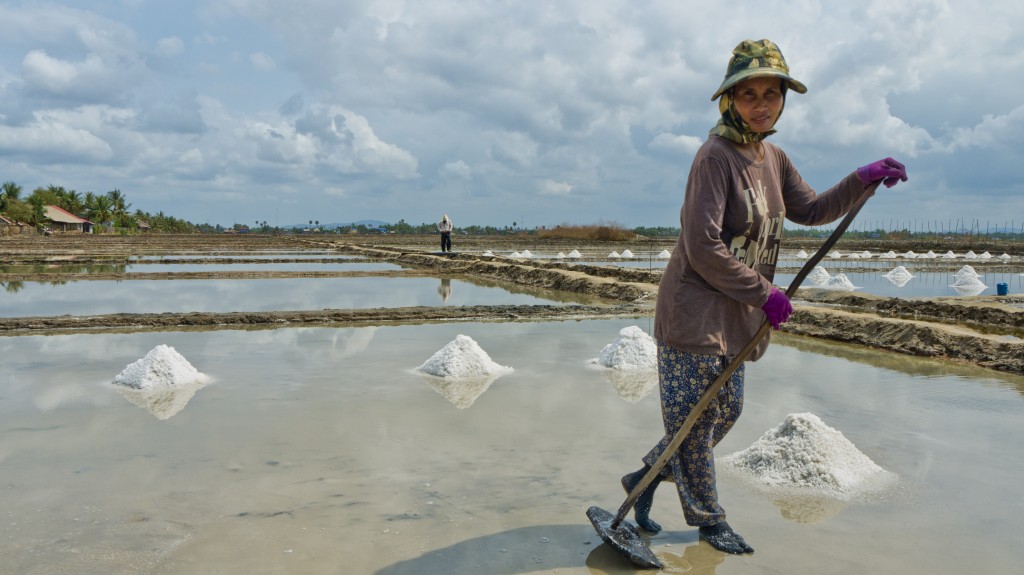
Woman working in the salt fields in Kampot. Photo by douglasjonesjr, taken on 28 March 2014. Licensed under CC BY 2.0.
Salt is produced in Kampot and Kep provinces, where seawater is allowed into salt evaporation ponds As the water evaporates, salt crystals are left behind and harvested. Production levels depend largely on weather, with long dry periods increasing annual production and rainfall reducing it. Cambodia’s domestic consumption of salt is estimated at about 100,000 tonnes annually.1 Cambodia salt was not exported until 2017, largely because of quality issues. However, there was a project to improve quality and begin a salt export industry.2
Salt production reached 147,000 tonnes in 2014, nearly double the 80,000 tonnes recorded in 2013.3 This is because the 2013 harvest season ended in April while dry weather allowed the 2014 season to run into June. However, the salt production dwindled from 170,000 tonnes in 2015 to just 140,000 tonnes in 2016 and decreased to only 32,000 tonnes in 2017.4
Salt Association of Kampot and Kep established in 2004 and presently 4,657 hectares of land are used for salt production5 which divided into 7 areas: Boeung Tuk, Traeuy Koh, Boeung Rung 1, Boeung Rung 2, Seh Sor, Kep, and Kampong Trach along the coastline starting from Boeung Tuk commune, Kampot district to Lok village, Russei Srok Kang Lech commune, Kampong Trach district, Kampot province next to the Vietnamese border.6
In a 50-kg sack, Cambodian premium salt sells for about $3, second-grade salt sells for $2.4, and third-grade for $2.2.7
New production venture
A donor-backed project launched in April 2013 aims to produce Cambodia’s first export-quality sea salt in Toek Chhou district, Kampot province.8 The $2.9 million venture is targeting 20,000 tons of salt each year for export from a 100 hectare model salt farm. The plan is to build a packaging factory.9
Asia Salt (Cambodia) Co., Ltd, a local subsidiary of a joint venture between South Korean Company EEE Korea and InfraCo Asia Development Pte. Ltd, is financed by the British, Swiss and Australian governments.
By introducing best practices in solar salt production, the project aims to make salt suitable for export to markets in South Korea and, potentially, Japan.
The capital cost of the first project phase is estimated at US$2.9 million. A second project phase, estimated at US$7 million, would increase production capacity, add a refining plant, and potentially enable the export of refined food-grade naturally evaporated sea-salt to a broader international market.10
If all Cambodian salt production reached the highest standards following international best practice, an estimated potential export industry worth up to $100 m annually could be created.11
Cambodia salt export
In recent years, Cambodia has exported its salt into the international market. In February 2017, under an agreement with French company, Le Guerandais, 20 tonnes of Cambodian salt are exported for the first time and sold at $58 per tonne.12 According to United Nations Comtrade Database, Cambodia salt and citric acid are exported to Netherlands about 900 tonnes which equivalent to $750.000 in the 2016.13
Last updated: 01 February 2018
Related to salt
References
- 1. Ministry of Industry and Handicraft. (2015). “National public forum in Kampot province: discussion for needs and suggestions from Salt Association in Kampot and Kep”. Accessed 01 February 2018. http://www.mih.gov.kh/File/UploadedFiles/6_10_2015_11_25_57_025-2015%20Public%20Forum%20at%20Salt%20Community.pdf
- 2. Chea Vannak. “Salt production in Cambodia still seasonal”. Khmer Times, 31 July 2017. Accessed 01 February 2018. http://www.khmertimeskh.com/5075584/salt-production-cambodia-still-seasonal
- 3. Hor Kimsay. “Salt makers shake out a big surplus”. Phnom Penh Post, 12 June 2014. Accessed 01 February 2018. http://www.phnompenhpost.com/business/salt-makers-shake-out-big-surplus
- 4. Sok Chan. “Rain keeping local salt farmers from harvesting”. Khmer Times, 12 January 2018. Accessed 01 February 2018. http://www.khmertimeskh.com/50101594/rain-keeping-local-salt-farmers-harvesting/
- 5. Ministry of Industry and Handicraft. (2015). op. cit.
- 6. Ministry of Industry and Handicraft. (2014). “H.E Senior minister Chorm Proseth visits and strengthens the management of salt community in Kampot and Kep province”. Accessed 01 February 2018. http://www.mih.gov.kh/File/UploadedFiles/7_22_2014_7_30_56_027-2014%20Salt%20Community%20Meeting.pdf
- 7. Sok Chan. “Rain keeping local salt farmers from harvesting”. Khmer Times, 12 January 2018. Accessed 01 February 2018. http://www.khmertimeskh.com/50101594/rain-keeping-local-salt-farmers-harvesting/
- 8. Simon Lewis. “New Kampot salt farm has big ambitions”. The Cambodia Daily, 29 April 2013. Accessed 01 February 2018. https://www.cambodiadaily.com/archives/new-kampot-salt-farm-has-big-ambitions-20505/
- 9. Ibid
- 10. Private Infrastructure Development Group. (2012). “PIDG Annual report”. Accessed 01 February 2018. https://www.pidg.org/wp-content/uploads/2018/11/PIDG-Annual-Report-2012.pdf
- 11. Ibid
- 12. Cheng Sokhorng. “First salt export deal crystallises”. Phnom Penh Post, 14 February 2017. Accessed 01 February 2018. http://www.phnompenhpost.com/business/first-salt-export-deal-crystallises
- 13. Robin Spiess and Cheng Sokhorng. “Cambodia’s critic acid exports prompt investigation in Europe”. Phnom Penh Post, 26 December 2017. Accessed 01 February 2018. http://www.phnompenhpost.com/business/cambodias-citric-acid-exports-prompt-investigation-europe

